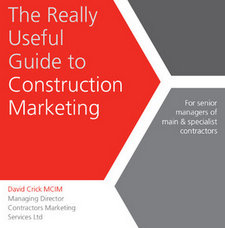
Creating a corporate image that brings in profitable work
GUEST BLOG. David Crick MCIM, from Contractors Marketing Services, explains how to manage your corporate image to enhance integrity and bring in new work.
Brands with integrity
How polished is your corporate image? Perhaps you know who you are and have given plenty of thought to how you are perceived. Perhaps you are happy to run on reputation and word of mouth – you might even say you don’t have a corporate image. Well let’s set that straight from the start: you have an image. It’s either one that you’re communicating on purpose, or it’s one that you’re broadcasting accidentally. Either way, people are forming an opinion about who you are and what you do.
Who knows what that opinion might be? People might think you’re professional and reliable, or that you’re dubious and best avoided. That view may be right or wrong, but the point is that unless you have thought about your image and been deliberate about it, you have no control over what people think.
It’s your business, so don’t leave it to chance. Take control of your image and shape it.
Corporate image that brings in work
A good starting point is to audit your existing image. Ask around. What do people think about your business? Ask your clients why they chose you. Have they got a positive view of your business? Those are the more intangible elements of a corporate image. There are more tangible ones to assess as well: do you have a logo, and is it consistently applied? Have you got a quality brochure, letterheads? How about vehicles and hoardings on site? Have you invested in your website, making it attractive and easy to navigate?
All these things matter. A cheap logo or badly written materials all undermine that critical first impression. No matter how good you are at what you do, those impressions can lose you work.
It might seem that spending money on design is a waste, especially if times are hard. But think about the times when you’ve been in the market for something. Consciously or unconsciously, our buying choices are influenced by packaging and presentation. We all know the difference between well branded goods and generic ‘no name’ versions.
Good design communicates quality and trust. It makes you memorable, and helps you to stand out in the crowded construction marketplace. It is worth investing in – it doesn’t have to be hugely expensive, but it does have to be professional.
As you work on your image, consider what your strengths are and how you can communicate them. Think about what makes you different. And don’t forget to look ahead too. Your brand needs to reflect who you are, and you can’t pretend to be something you’re not. But a brand can also be aspirational. Think about the firm you want to become in three or four years, project that image and grow into it. Developing your corporate image can help you to develop your business.
Marketing Guide
 Download the CMS Really Useful Guide to Construction Marketing.
Download the CMS Really Useful Guide to Construction Marketing.
If you’re a member of the CIOB, you can read it as part of your continuing professional development.
More Guest Blogs from David Crick
How to achieve long term partnerships with contractors
Marketing: 10 ways to make your business distinctive
Latest news

26th July 2024
Enfield Speciality Doors completes world-class project for Atlas Copco HQ
A rundown office and warehouse building completely transformed into a modern headquarters for Atlas Copco has been fitted with more than 120 internal fire doors from Enfield Speciality Doors.
Posted in Access Control & Door Entry Systems, Articles, Building Industry News, Building Products & Structures, Building Systems, Case Studies, Doors, Interior Design & Construction, Interiors, Posts, Restoration & Refurbishment, Retrofit & Renovation, Security and Fire Protection, Sustainability & Energy Efficiency, Timber Buildings and Timber Products, Wooden products
26th July 2024
Abloy UK launches new white paper
Abloy UK, a leading provider of security and access control solutions, has launched a new white paper.
Posted in Access Control & Door Entry Systems, Architectural Ironmongery, Articles, Building Industry News, Building Products & Structures, Building Services, Doors, Facility Management & Building Services, Health & Safety, Information Technology, Innovations & New Products, Publications, Research & Materials Testing, Security and Fire Protection
26th July 2024
MCRMA Member Profile: David Roy, Director of Roofconsult
David Roy of MCRMA member company Roofconsult has more than 50 years’ experience to draw upon working in the building envelope sector and a unique perspective on how it has changed in that time.
Posted in Articles, BIM, Infrastructure & CAD Software, Building Associations & Institutes, Building Industry News, Building Products & Structures, Building Services, Building Systems, Cladding, Information Technology, Restoration & Refurbishment, Retrofit & Renovation, Roofs, Walls
26th July 2024
Strand: Enhancing Door Functionality and Safety
Craig Fox, Sales Director for Strand Hardware, outlines how door industry professionals might apply door limiting stays…
Posted in Architectural Ironmongery, Articles, Building Industry News, Building Products & Structures, Building Services, Doors, Facility Management & Building Services, Health & Safety, Restoration & Refurbishment, Retrofit & Renovation
 Sign up:
Sign up: